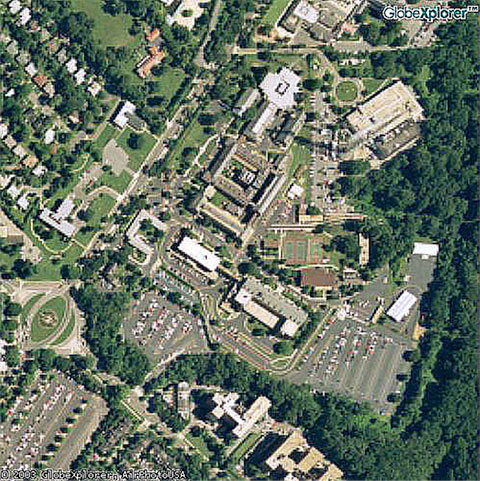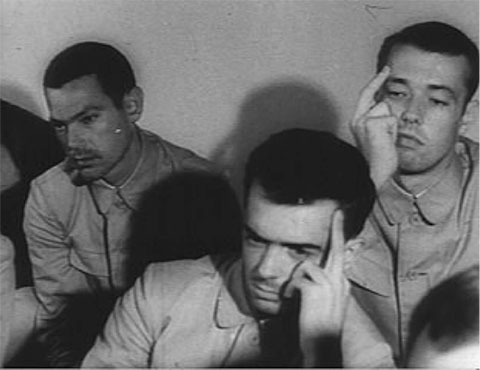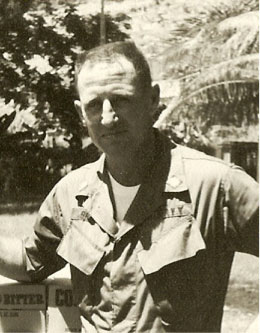Damage Assessment
Editor’s Note: The following interview with Mac Showers was conducted on 04 May, 2011. We could have had no way of knowing how crazy things were going to get, but there was some material that suggest things have been pretty nuts before, and likely will be again. Nothing as strange as the story of Jack Graf is likely to be told any time soon, regardless of what Wikileaks comes up with.
-Vic

(The Nebraska Avenue Complex in NW DC. Building 3801 is to the upper right. The compound was a girl’s school at the beginning of World War II and occupied by the Navy to house STATION NEGAT. Photo GlobeXplorer.)
We were at our weekly session at the Willow bar. It was the day before Cinco de Mayo, and life was good.
“I am headed up to NSA tomorrow,” declared Mac. “They have asked me to talk about Station HYPO at Pearl, and the contributions of code-breaking to the victory at Midway.”
“That is Saturday the 4th, right?” I said, waving to Elizabeth-with-an-S for more Happy Hour White. She brushed a lock of chestnut hair over her ear and nodded. The Willow bar was rocking. Food was arriving in front of the throng at the bar, and Mac and I were midway down the rail.
Ray and Old Jim anchored the Amen Corner by the door with Jon-no-H, the Lovely Bea and Short Hair Mike. Jake was talking to The Greek and Jeff further down the line. It was a good crowd, and it looked like Willow was doing a land-office business.
“Yes, they are going to have the ceremony on the third, to commemorate the 69th anniversary. I imagine they are going to have something really big next year for the 70th. They were going to do it in the headquarters, but they changed the venue to the base theatre, which can hold around four hundred people.”
“You are about the last man standing,” I said. “That is really something.”
“Well, that may be true but I had NSA arrange a wheelchair for me. I told them I’ve walked those endless halls in the Headquarters!”
I had forgotten my notebook and was back to napkins. I fished out my pen, took a deep draft of delightful crisp Happy Hour white.
“So,” I said, launching into my list of questions. “At Building 3801 at Nebraska Avenue they put together everything they knew they had on the ship. They had way more than they should have- the classified pubs officer said they were going to get around to purging things but didn’t have time, according to the Board of Inquiry.

(Pueblo sailors flip off their captors for the camera. Photo courtesy DPRK.)
“They did not have thermite grenades. CDR John Lacey at COMNAVFOR Japan had been very thorough in providing Pueblo with all the Fleet Intelligence Collection Manual and the Special Intelligence Collection Requirements documents, even if they had nothing to do with Korea.” Mac frowned.
“They got the FICM and all the SICRs? For the whole Pacific?” I said in wonder.
“Yep. Plus, we had to assume that everything that had been sent on the Fox Broadcast during the deployment. That is what we called the Special Intelligence net, and all the traffic would have been retained in the files. Not to mention the hardware- radios, cryptologic equipment and the codes to go with it. The whole shooting match.”
“Damn,” I said. “That is about the whole shooting match of how we do business. Who did they give you to work through it all?”
Mac pursed his lips. “I had good talent. NSA and the Navy Security Group were there, of course. I think, Joe Amato was there, and ONI gave me Bill Harris, and there was that gay Counter-intelligence guy. Everyone knew, but it was still sort of odd for the early 1970s.”
“Being a counter-intelligence officer is a good place to be gay in, if your organization considers it criminal.”
“True. And then there was Wanda. She was fresh to the agency- early twenties, and she was a knock-out. She used to wear those mini-skirts to work. She did everything- typing and admin work and every day she would sweep up- she was a thrill to watch!”
Jake asked: “When did you last see the Damage Report? I know there was still a copy at CNO- Intelligence Plot when I was there. Someone wanted to clean it out, since it was taking up space in the vault.”
“We don’t care much about our history. All those special submarine base mission reports were retained on microfiche, and they are disintegrating.”
Mac cleared his throat and took a sip of his Virgin Mary. “We gave the assessment to General Joe Carroll, the first Director of the Agency. He headed the DIA from its establishment in 1961 as a special unit to coordinate the intelligence activities of the separate services until he retired in 1969.”
“That is quite a run.”
“He was an odd duck, that is for sure,” said Mac. “He was fierce about protecting Air Force equities, which is why I was Chief of Staff and not the Deputy. Anyway, there were enough copies for him and the USIB- the United States Intelligence Board. Back then it was State, CIA, the Services, no Marines, though John Guenther changed that, NSA, COMIREX…all the INTs were represented.”
“General Carroll presented the report. He always went to those meetings by himself.”
“Director Bennett made me Chief of Staff. We had a tight relationship- he said “I am going to be Mr. Outside and you are going to be my Mr. Inside.””
“Now, in those days there were three uniformed officers in the leadership chain. The Number Two guy was an Air Force three-star named Philpott. General Carroll lobbied hard to get a Zoomie as number two. Rufus Taylor at Navy tried to influence that, or to have me assigned as the director of analysis, but Carroll was having none of it. He left in 1969, and that is when General Bennett came in.”
“Were you friends with Vice Admiral Taylor?”
“Oh, yes, we were great pals. We were together at Arlington Hall in the predecessor organization to NSA- the Armed Forces Security Agency. One day we went for a walk and he told me he had been thinking about his future.”
“Didn’t he start out as a Cryppie?”
“That was the point. He was thinking about applying for a lateral transfer to Intelligence, and I told him it was a good idea. He was the only Navy officer who ever switched communities and he did pretty well.”
“No,” I said. “He was the first, but Jerry Clark did it later. He wound up as the civilian Deputy at DIA after he retired from the Navy.”
“Still unusual,” he said.
“Well, considering you started out doing code-breaking for Joe Rochefort at Station Hypo in Pearl Harbor, you could have been either one.”
“And now they are mixing everything up again,” he said.
“They think the Radio Wars are over.”
“Maybe they are. We’ll see.”
“So were you working full-time on the Damage Assessment for three months?”
“Goodness no. I would spend the morning in the Pentagon going to budget meetings and then go over to Nebraska Avenue in the afternoon. The Program never sleeps, you know, and I was the DIA-PL. General Carroll had an acronym for everything. The title was “DIA Plans and Program.” We called it Diapple. I had a good Air Force Colonel working for me, and together we were able to cover it while still producing the Assessment.”
“I remember when I was Staff Director,” I said, thankful that my Pentagon days were done. “It was all about meetings. It was excruciating.”
“I hated plans and programs. When General Bennett came in he made me Chief of Staff.”
“That is still a lot better than doing the Program,” I said with a shiver. “Although I have to say that learning how the money flows was pretty useful after I retired.”
“Philpott was the most worthless officer I ever knew on active duty,” said Mac with a scowl. “There was never a thing on his desk except his feet. His in-basket was the top right drawer on his desk. Didn’t matter what time of day you went in. That desk was clean as a whistle.”
Bennett had been a European commander- never had been to Vietnam, even though he had a great combat record. He was in the second wave at D-Day and his unit took 50% casualties.”
“But he was Fulda Gap Army,” I said. “Focused his whole career on the Group of Soviet Forces in Germany.”
“Exactly. He did not know a lot about the Pacific. So, early on in his tenure he said he was going to go to Theater and talk to all the Commanders in every Corps area. I had just come from PACFLT, so he left that idiot Philpott in charge and took me along to interpret for him. We went to all of them for at least a night. The Marines at Da Nang were the only non-Army units we talked to until we got to Saigon.”
“That is where the mystery happened, right? I still don’t understand that one.”
“Oh, you mean when I saw Captain Rex Rectanus at dinner with Admiral Zumwalt at NAVFOR-V?”
“Yes. That still freaks me out. Rex transferred from Vietnam back to the Hoffman Building in Alexandria the year before that trip to be the collections requirements officer for the Director of Naval Intelligence.”
“But I saw him across the table from General Bennett that night when we visited in 1970.”
“That does not make any sense,” I said. “I have talked to the guy who relieved him. He does not recall Rex being back in country, though he thought he was up at Long Binh when you and the Director of DIA were there.”
“Well,” said Mac thoughtfully “There is the possibility that there was something that required Rex to be back there.”

(CDR Jack Graf in Vietnam, 1969. Official Navy Photo.)
“You mean the Jack Graf affair?” I said. “I was proud to help Admiral Rex on his campaign to have Jack memorialized as the only Naval Intelligence Officer to be captured and killed while trying to escape captivity.”
“There were reports of his being held alive during that period down south in the Delta.”
“There were some very strange things about the whole story, though.” I drained my glass of wine, and felt exactly at that place you want to be at Willow: light, but not weightless.
“It was a matter of supreme importance to Rex, and the more I found out about things the stranger it got. You know the Naval Intelligence Liaison Officers assigned to the River Divisions and field units normally did not have the really special clearances in case something happened to them.
“Yes,” said Mac. “What you don’t know cannot be compromised. It is a lesson we should have learned before Pueblo.”
“That is my point, Admiral.” I shuffled the stack of napkins on the bar in front of me. “When I was doing the research into Jack’s career, I found out he was one of the first officers sent to the special school at Kodak. Jack had been photo interpreter at Building 213 at the Navy Yard.”
“Yes, the National Photographic Photo Interpretation Center, which at that time was the only place that satellite imagery was analyzed. Very hush-hush.”
“Yessir,” I said. “And that is my point. When Jack was there, they were still working with the early satellite systems that had to physically de-orbit film canisters and snag them from C-130 aircraft.”
“Right. That was the Catch-a-Falling-Star unit out of Hawaii. I knew them when I was the N2 at PACFLT.”
“Well, that was sort of a cumbersome system. Engineers like my Uncle Jim at Kodak were working on something much better. They figured out how to transmit high-quality imagery from space back to earth. That is what was going to revolutionize space-borne reconnaissance.”
“It made satellite intelligence nearly real-time,” said Mac. “It was a huge advance.”
“Bingo,” I said. “And Jack had been to the course right before he volunteered to go back to Vietnam. The whole thing was so secret that the personnel system probably did not recognize what Jack was carrying in his head.”
“So you think maybe the Viet Cong figured out that they had someone really special in their hands?” Mac looked quizzical.
“I don’t know. But I do know there was never a body found, and the only testimony after the war was that he was shot trying to escape. The Vietnamese claimed they buried him in a river bank that subsequently washed away.”
“So you think Rex was back in Vietnam to check into the matter on the QT, so that there would not be a tip-off that something amazing had gone missing?” Mac rose from his stool.
“No body was ever found. Jack could be anywhere. Even Russia.”
“I suppose you are right,” he said as we walked toward the door. “It could be that Rex was back in Vietnam to do his own version of a Damage Assessment.”
Copyright 2016 Vic Socotra
www.vicsocotra.com
